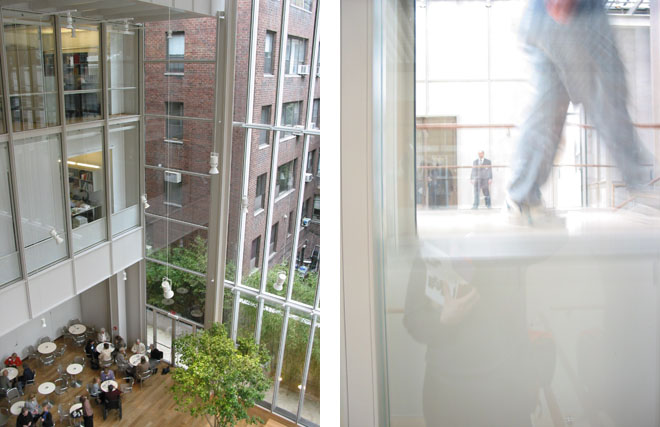I’m no architecture critic, but when I read the New York Times review of the just-reopened Morgan Library & Museum a few weeks ago (with words like “dazzling”, “mesmerizing”, and “triumph”) I knew I had to visit as soon as I could. So immediately following my class field trip the other day, I dismissed my students and walked a single a block up Madison Avenue to see what all the talk was about.
The Morgan Library has in the past been perceived as a second-tier New York museum, not quite at the level of the Metropolitan, MoMA, or Guggenheim. But from the moment you first walk into the new Morgan Libary, the entranceway and courtyard immediately make a strong, visceral case for moving the Morgan up into that exclusive pantheon of great New York institutions.

I could not take photographs within the galleries themselves, but maybe you can get a sense of the lobby’s bright energy from these images. It is a remarkably elegant and powerful space: despite the massive scale it succeeds in making the visitor feel welcome and unrushed. I was surprised by how intimate the experience was, both in the lobby and in the exhibition galleries.
The courtyard largely serves to connect the older McKim Mead & White buildings which used to comprise the original library. These interiors simply have to be seen to be believed. I told someone that being in J.P. Morgan’s personal libary — a massive single room with three stories of bookshelves, secret doorways, and a fireplace big enough to drive a car through — was like visiting Charles Foster Kane‘s Xanadu. It took me a few moments to realize that Mr. Morgan was probably far richer than even Kane was supposed to be.
The collection, of course, is the whole point of the museum. It includes drawings and works on paper, original musical scores, and literary manuscripts from pretty much every canonical artist, writer, composer from the past four hundred years, medieval reliquaries and liturgical objects, Mesopotamian cylinder seals, paintings and sculptures, and of course lots of books: scrolls, ancient illuminated manuscripts, and early printed editions from around the world, both religious and secular.
I will likely visit again very soon, as I was in a rush and spent less than an hour visiting the museum. I saw a couple of things I thought were super cool:
- The first book on architecture ever printed: Although the author’s intent was to write so vividly that illustrations would not be necessary, the book’s owner apparently thought otherwise and made his own architectural drawings right on the book’s pages, usually overlapping the text itself.
- A tiny illuminated manuscript illustrated by Giulio Clovo: Clovo was praised by Vasari as a “new, if smaller, Michaelangelo”. It’s funny how artists who painted big images on public walls are remembered to this day, but those who painted tiny masterpeices in privately-owned one-of-a-kind books are largely unknown. Here’s to Giulio Clovo!
Obviously there’s a lot more to see. Although the museum is small in terms of square footage (there are really only a handful of exhibition galleries… maybe five?), each object demands and commands more attention than the works in a standard art museum usually do for me.
Visiting on a weekday, especially now during its post-opening excitement, is probably better then going on a weekend. If I worked in the immediate neighborhood I’d seriously consider becoming a member and spending the occasional lunch hour (ha!) there, contemplating the works on display (they turn the pages of the books on display to help preserve them, so the work would be fresh). In fact, Behavior is only a brisk ten minute walk away, so I may give that idea more consideration.
I had never visited the Morgan Library before the renovations, and I realize now that it was a big mistake. Hurry now to see the collections!